Can we help you?
Contact us

Can we help you?
Contact us

Thank you for contacting us
Your form has been submitted successfully Our team will contact you again as soon as possible.
Whooppss...!! An error has occurred
Try sending later or write an email directly to areaempresas@ua.es

INFO
SHEET
DOWNLOAD
EXECUTIVE
ABSTRACT
CONTACT DETAILS: Research Results Transfer Office-OTRI
University of Alicante
Tel.: +34 96 590 99 59
Email: areaempresas@ua.es
http://innoua.ua.es
The Institute of Organic Synthesis and the Institute of Water and Environmental Sciences, both affiliated with the University of Alicante, have jointly developed a mixture extractant composed of a process ionic liquid (TSIL) and an ionic liquid (IL) that allows the selective and efficient extraction of rare earth metals, uranium and thorium compared with other metals from the s, p and/or d series.
This technology is characterised by the fact that the extractant mixture can be reused in new extraction cycles without loss of effectiveness, representing a major advance in sustainability and environmental protection. This novel formulation can mainly be applied to the treatment of phosphogypsum waste. After the separation of the mentioned metals, they could be used in the manufacture of electronic components and in energy generation, respectively. Additionally, a purified gypsum would be obtained, highly useful in the construction sector. Thus, sustainable recovery presents significant added value.
Other applications of this technology in areas such as mining, nuclear chemistry, nuclear medicine and the treatment of nuclear waste are potentially interesting.
Companies interested in acquiring this technology for commercial exploitation through patent licence agreements are sought.

Rare earth elements are the common name for seventeen chemical elements: scandium, yttrium and the fifteen elements of the lanthanide group (lanthanum, cerium, praseodymium, neodymium, promethium, samarium, europium, gadolinium, terbium, dysprosium, holmium, erbium, thulium, ytterbium and lutetium).
All these elements are characterised by being scarce and widely dispersed in the Earth's crust. Separating one (or several) elements from this block, as well as uranium and thorium from other metals of the s, p and/or d groups, is a difficult, tedious and very costly task.
In general, rare earth elements are used as highly effective catalysts in industrial chemical processes. However, they gain greater relevance as essential components in more than 200 high technology consumer products across a wide range of applications, such as mobile phones, hard drives, electric and hybrid vehicles, flat screen monitors and televisions, optics, and military defence applications (manufacture of electronic displays, guidance systems, lasers, radar and sonar systems), etc.
On the other hand, uranium and thorium are metals belonging to the actinide group. They are radioactive and release energy through their respective decay chains. Natural uranium and thorium, and artificially produced plutonium, are the most abundant actinides on Earth, and are primarily used in nuclear reactors, nuclear weapons and nuclear medicine.
The high cost of chemical reagents (especially in acidic leaching), the energy required for the processes, the complexity of the technology employed and poor sustainability make the recovery of rare earth elements, uranium and thorium a difficult issue to handle efficiently in phosphogypsum purification.
Focusing on this residue from the phosphoric acid industry, the methods used to separate and obtain rare earth elements, uranium and thorium free from other s, p and d series metals are varied, and most of them rely on low sustainability liquid liquid extraction procedures. The use of ionic liquids (Ionic Liquids [IL]) has been fundamental in many examples of selective chemical separation; however, the use of process ionic liquids (Task Specific Ionic Liquids [TSIL]) combined with ionic liquids [IL] has not been used as frequently.
In any case, to date no procedure has been carried out to recover the TSIL IL extractant system; only studies to recover the metal (decomplexation or stripping) at the end of the extraction process have been conducted.
Therefore, there is a need to obtain an extractant formulation and a procedure that allows selective extraction of rare earth elements, uranium and thorium against the rest of the metallic elements of the s, p and d series, and that can also be used in repeated extraction cycles without losing selectivity or effectiveness.
To address the previously described problems, an extractant mixture has been developed consisting of a process ionic liquid TSIL (see the chemical formula in Figure 1) dissolved in an ionic liquid IL (see the chemical formula in Figure 2).
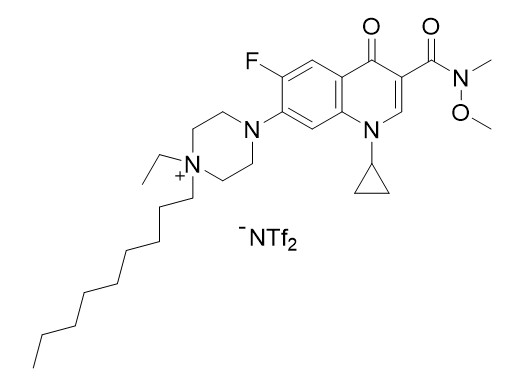
Figure 1: TSIL compound

This extractant mixture is characterised by allowing the selective liquid liquid extraction of the rare earth metals, uranium and thorium in samples that contain other s, p and/or d series metals.
The procedure for preparing the aforementioned TSIL compound is carried out in a very simple manner from the antibiotic ciprofloxacin using conventional functional group transformations. The synthesis of this compound takes place in three stages conducted under mild reaction conditions (temperature between 0°C–25°C, atmospheric pressure, etc.).
Stage 1: N-alkylation of ciprofloxacin with 1 bromopropane in the presence of excess N,N-diisopropylethylamine to generate the following intermediate (see Figure 3) with a yield of 88%:
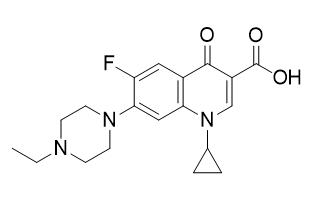
Figure 3: Reaction intermediate
Stage 2: Amidation of the previous compound using an excess of N,O-dimethylhydroxylamine in the presence of thiourea chloride to obtain the following Weinreb amide (see Figure 4) with a yield of 86%:
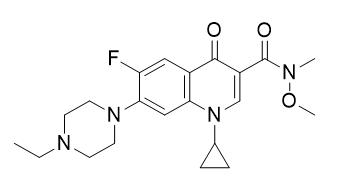
Figure 4: Weinreb's amide
Stage 3: Alkylation of the previous compound by adding an excess of 1 iodononane and subsequent ion exchange with lithium bis(trifluoromethanesulfonyl)amidate to obtain the previously indicated TSIL molecule (see Figure 1) with a yield of 92%.
On the other hand, the selective extraction procedure for rare earth metals, uranium and thorium from a sample containing metals from this block together with other s, p and/or d series metals is as follows:
1) Prepare the extractant mixture (B) consisting of the TSIL compound from Figure 1 and the ionic liquid CYPHOS NTf2 from Figure 2.
2) Introduce the sample to be separated (A) into a test tube; it contains one or more f-block metals and other metals from the s, p and/or d series. Adjust the pH to 6.
3) Add the extractant mixture (B) to the sample to be separated (A).
4) Stir for at least 3 minutes.
5) Wait until two liquid–liquid phases of different densities separate.
6) Separate both phases, with the organic phase corresponding to the extractant mixture (B) that contains the f-block metal(s) initially present in the sample to be separated (A) (see Figure 5).
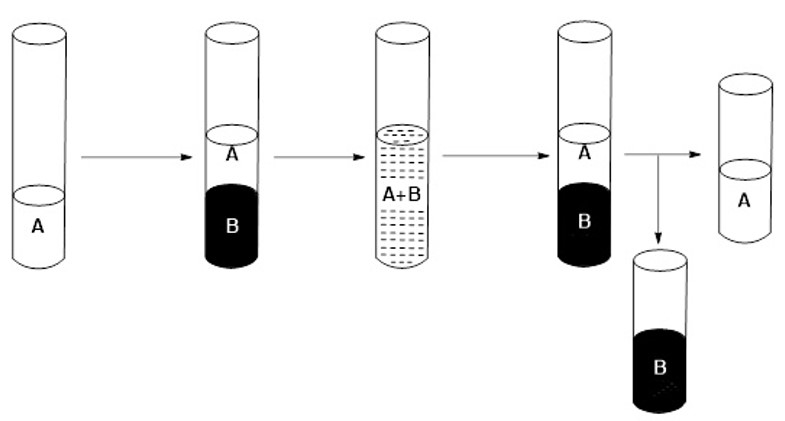
Figure 5: Scheme of the selective extraction process
7) Add to the recovered organic phase (B) an acidified solution at pH=0.5 (C) (see Figure 6).
8) Stir.
9) Wait until two liquid–liquid phases of different densities separate.
10) Separate the two phases, where the organic phase corresponds to the metal-free extractant mixture (B) and the aqueous phase (C) contains the f-block metal(s) (see Figure 6).
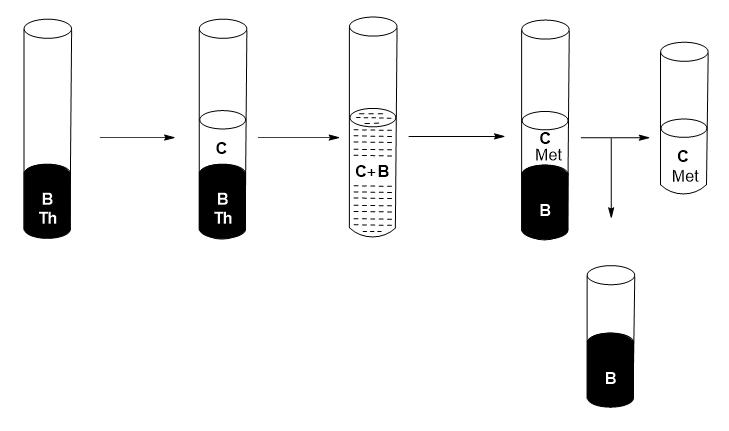
Figure 6: Scheme of the extractant mixture recovery process
The extractant mixture (B) can be reused in successive new extraction cycles without loss of selectivity or effectiveness.
ADVANTAGES OF THE TECHNOLOGY
This novel extraction procedure has the following advantages:
1) Allows the selective extraction of internal transition metals (f-block), especially those classified as rare earths, uranium and thorium, against metals belonging to the s, d and/or p blocks of the periodic table in a highly effective manner.
2) The extractant mixture is reusable: once the extraction procedure is complete, it is possible to fully recover the metal(s) complexed, allowing the extractant mixture to be used in new extraction cycles.
3) The extractant mixture has a low affinity for metals from the s, d and p series of the periodic table, so metals from these series are extracted with a low or negligible percentage.
4) The recovery percentage of the extractant mixture is, at least, 95%, so it can be reused in new extraction cycles once the extracted metals have been released.
5) The extraction procedure is environmentally friendly.
6) The procedure is carried out under mild reaction conditions (temperature between 0°C–25°C and atmospheric pressure).
7) Both the TSIL compound and the solvent CYPHOS NTf2 are commercially affordable (or can be easily prepared via a simple ion exchange).
8) The procedure is industrially scalable, able to be adapted and implemented to meet the company's needs. It efficiently and sustainably recovers, separately, rare earth metals, uranium and thorium, and produces high purity gypsum.
In summary, the new extractant mixture is a revolutionary technology that significantly improves current methods for extracting rare earth metals, uranium and thorium from waste generated in the phosphoric acid industry (phosphogypsum).
INNOVATIVE ASPECTS OF THE TECHNOLOGY
This novel chemical composition allows selective and efficient extraction of rare earth metals, uranium and thorium against other metals from the s, d and/or p series of the periodic table. In this sense, the primary interaction of internal transition metals with the TSIL, which acts as a selective chelator, occurs through the 1,3 dicarbonyl region.
Furthermore, once the extracted metals have been separated, the original extractant mixture is recovered with a yield exceeding 95%, allowing its subsequent use in new extraction cycles, making it a sustainable and environmentally friendly procedure. No other extraction system with these characteristics is available on the market that is reusable.
This methodology adapts exceptionally well to a separation process of rare earths, uranium, thorium and high quality gypsum from waste derived from the fertilizer industry that generates phosphoric acid (impurified phosphogypsum).
The trials conducted have shown very promising results. Below is a table with the distribution coefficient of the analyte (K), which is the ratio of the metal concentration in the organic phase to its concentration in the aqueous phase after the extraction procedure (see Table 1).
With these trials, the high efficiency and great selectivity of the extractant mixture have been demonstrated, as a higher distribution coefficient (K) of the analyte corresponds to greater extraction efficiency.
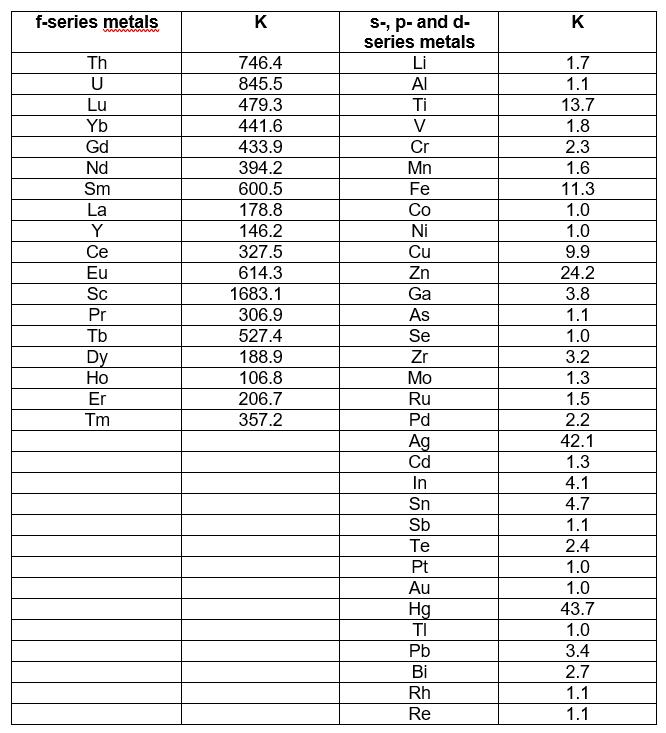
Table 1: The distribution coefficient (K) values obtained for the f-block metals, as well as for other metallic elements of the periodic table that may be present with them, at pH=6.
This novel composition can selectively extract internal transition metals against other metals of the periodic table at pH=6.
The main application sectors for this novel technology are:
• Fertiliser industry that generates phosphoric acid.
• Mining.
• Nuclear chemistry.
• Nuclear medicine.
• Nuclear waste treatment.
• Scientific research.
With this technology, the problem of selective separation of the chemical elements belonging to rare earths, uranium and thorium, some of which are used as fuels in nuclear power plants, is solved. The selective separation of these metals relative to the rest of the metals collected in the periodic table is crucial, both in the extraction process of the initial phosphogypsum waste and in the treatment of nuclear waste products. Its application in various industrial sectors can have a positive impact on the environment and can contribute to improving global energy sustainability.
Companies interested in acquiring this technology for commercial exploitation through patent licence agreements are sought.
Desired company profile:
• Phosphoric acid derived industry.
• Mining.
• Chemical industry.
• Nuclear industry.
• Nuclear medicine.
• Nuclear waste treatment.
The present invention is protected through patent application:
• Patent title: "Compuesto TSIL, procedimiento de preparación y procedimiento para la extracción selectiva de elementos de transición interna frente a metales de las series s, d y p empleando el compuesto TSIL ".
• Application number: P202330797.
• Application date: 25th September 2023.
Geological and Geophysical Studies
Medicine and Health
Chemical Technology
Carretera San Vicente del Raspeig s/n - 03690 San Vicente del Raspeig - Alicante
Tel.: (+34) 965 90 9959




